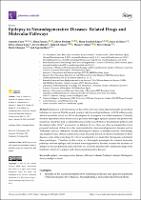Resum
Paraules clau
Malaltia d'Alzheimer; Malaltia de Huntington; Malaltia de Parkinson
Citació recomanada
Cano A, Fonseca E, Ettcheto M, Sánchez-López E, Rojas I de, Alonso-Lana S, et al. Epilepsy in Neurodegenerative Diseases: Related Drugs and Molecular Pathways. Pharmaceuticals. 2021 Oct;14(10):1057.
Audiència
Professionals
Empreu aquest identificador per citar i/o enllaçar aquest document
https://hdl.handle.net/11351/7488Aquest element apareix a les col·leccions següents
- HVH - Articles científics [2958]
- VHIR - Articles científics [1198]
Els següents fitxers sobre la llicència estan associats a aquest element:

